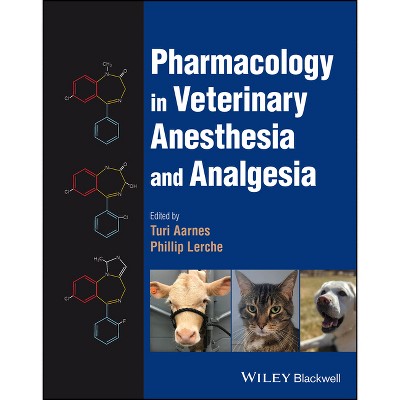About this item
Highlights
- Vermittelt ein umfassendes Verständnis sämtlicher Krankheiten, die bei Ziegen in unterschiedlichen geographischen Lagen und unter einem breiten Spektrum von Haltungsbedingungen auftreten können, von der extensiven Weidehaltung über die intensive Milchproduktion bis zur Heimtierhaltung.
- About the Author: The Authors Mary C. Smith, DVM, Diplomate, ACT, is a Professor in the Department of Population Medicine and Diagnostic Sciences at New York State College of Veterinary Medicine, Cornell University in Ithaca, New York, USA.
- 976 Pages
- Medical, Veterinary Medicine
Description
About the Book
"The first and second editions of Goat Medicine were well received, and we are pleased to have the opportunity to produce a third edition. Since the second edition appeared in 2009, the global landscape for veterinary medicine and for goats has continued to change. Goat numbers worldwide now exceed 1 billion, reflecting the ever-growing demand for goat products in the meat, dairy and fiber sectors and the recognition that goats are versatile, resilient and highly adaptable, making them an increasingly attractive form of hoofed livestock in regions where climate change is resulting in warmer, more arid conditions. Climate change is also affecting global patterns of disease, particularly vector-borne disease, as vector ranges expand in association with warming temperatures. This has implications for goats. Bluetongue, for example, which is transmitted by Culicoides midges, is now present in every continent except Antarctica. Its presence in Europe has been steadily expanding northward, affecting goats and other ruminant animals in countries where it had not previously been noted. There are concerns that other serious vector-borne diseases of goats, notably Rift Valley fever, may eventually become established in Europe due to warming temperatures. Other diseases, such as leptospirosis, though already present, may become more common due to increased rainfall and associated flooding. Around the time that the second edition of Goat Medicine was published, a single case of bovine spongiform encephalopathy (BSE) had been confirmed in a clinically normal goat at slaughter in France and it was unclear if BSE was going to emerge as an important disease in the species. However, since that report, countries throughout the European Union have conducted extensive slaughter surveillance in small ruminants, searching specifically for transmissible spongiform encephalopathies. This surveillance indicates that the initial caprine BSE case was an isolated occurrence and there is little evidence that BSE is a concern in goats. Nevertheless, that same surveillance activity revealed that scrapie was occurring in goats at about the same frequency as it does in sheep, underscoring the need for practitioners to include scrapie in their diagnostic assessments of live goats showing neurological signs"--Book Synopsis
Vermittelt ein umfassendes Verständnis sämtlicher Krankheiten, die bei Ziegen in unterschiedlichen geographischen Lagen und unter einem breiten Spektrum von Haltungsbedingungen auftreten können, von der extensiven Weidehaltung über die intensive Milchproduktion bis zur Heimtierhaltung. Die dritte Auflage von Goat Medicine ist ein umfassendes Referenzwerk für Ziegenkrankheiten in allen Ländern der Welt. Die beiden Autoren ? approbierte Tierärzte mit weltweiter Erfahrung im Bereich Ziegenzucht und -gesundheit ? präsentieren in diesem Werk die neusten Fortschritte bei Diagnose- und Therapieverfahren sowie eine umfassende Betrachtung aller wesentlichen Krankheiten der Ziege. Das Buch enthält maßgebliche, klinisch relevante Informationen zur Erkennung, Diagnose, Behandlung, Bekämpfung und Vorbeugung von Ziegenkrankheiten beim Einzeltier, bei einer Herde oder sogar auf nationaler Ebene. Zum leichteren Verständnis und um die Inhalte des Buchs mühelos erlernbar zu machen, ist das Buch logisch nach Körpersystemen gegliedert und durchgängig mit farbigen Abbildungen illustriert. Behandelt werden u.a. die folgenden Themen:* Bekämpfung wirtschaftlich relevanter Infektionskrankheiten wie der Caprinen Arthritis-Encephalitis, der Paratuberkulose und der Pest der kleinen Wiederkäuer sowie innerer und äußerer Parasiten
* Differenzialdiagnose bei chronischem Gewichtsverlust und plötzlichem Tod, Anästhesie und Enthornung/Drüsenentfernung
* Ernährung und Stoffwechselkrankheiten, Management der Herdengesundheit und Präventivmedizin
* Arzneimittelliste für Ziegen mit empfohlenen Dosierungen sowie Möglichkeiten der Alternativmedizin Wissenschaftler, Forscher, Amtstierärzte, Labordiagnostiker, Industrietierärzte, Veterinärtechniker und behandelnde Tierärzte in aller Welt können sich mit gutem Gewissen auf dieses Buch verlassen und es bei Bedarf jederzeit als umfassendes Referenzwerk zu sämtlichen Themen rund um die Gesundheit und die Krankheiten von Ziegen verwenden.
From the Back Cover
Provides readers with an in-depth understanding of the full range of diseases potentially occurring in goats across the wide spectrum of geographic and management conditions in which goats are kept, from extensive grazing to intensive dairy production to backyard pet.
Goat Medicine, Third Edition is a complete resource for understanding caprine diseases worldwide. Covering the latest advances on diagnostic and therapeutic techniques, the two authors, board certified veterinarians with a global experience in goat health and production, offer a comprehensive examination of all important diseases encountered in the goat. The book offers authoritative and clinically relevant information on recognizing, diagnosing, treating, controlling and preventing goat disease at the individual, herd, and national levels.
To aid in reader comprehension and promote seamless assimilation of the knowledge contained within, the book is logically organized by body system and includes full color images throughout. Sample topics covered within the work include:
- Control of economically important infectious diseases including caprine arthritis encephalitis, paratuberculosis and peste des petits ruminants, as well as internal and external parasites
- Differential diagnosis of chronic weight loss and sudden death, anesthesia, and dehorning/descenting
- Nutrition and metabolic diseases, herd health management, and preventive medicine
- Formulary of drugs used in goats and suggested dosages, plus options for alternative medicine
Scientists, researchers, government veterinarians, laboratory diagnosticians, industry veterinarians, veterinary technicians, and veterinary practitioners around the world can confidently consult this book time and again as an all-in-one, complete resource for all topics pertaining to goat health and disease.
Review Quotes
"The authors of Goat Medicine were again successful in providing relevant and important updates of their well-known text and have once again improved this excellent resource. The books format, level of presented detail, and global perspective ensure that it continues to be a valuable resource for goat veterinarians, academic clinicians and scientists, veterinary students, and many other stakeholders in the goat industry."
- Jenna E. Bayne, Thomas Passler, and Joan D. Rowe, published in Small Ruminant Research, Volume 222, May 2023
About the Author
The Authors
Mary C. Smith, DVM, Diplomate, ACT, is a Professor in the Department of Population Medicine and Diagnostic Sciences at New York State College of Veterinary Medicine, Cornell University in Ithaca, New York, USA.
David M. Sherman, DVM, MS, Diplomate, ACVIM, is a Programme Coordinator in the Capacity Building Department at the World Organisation for Animal Health (OIE) in Paris, France.












